
Wine Culture and Information since 2002 - Volume 22
 Wine Culture and Information since 2002 - Volume 22 |
|
Issue 84, April 2010 |
Contents |
|
|
To the Origin of Genuineness |
|
In the past recent years the world of wine has lived alternating moments of glory, from the striking success of the 1990s - a real renaissance for Italian enology and for other countries - up to the not truly florid period, according to a commercial point of view, of the most recent years. In all of this time many producers have developed a certain conscience about the integrity and genuineness of their wines, also thanks to the use - or maybe, the abuse - of technological tools. The many techniques, in particular the many chemical substances used in wine making, have been widely discussed and debated, by praising their advantages as well as their disadvantages, as well as the effects on the health of consumers. Chemical substances used in wine making - it should be noticed - are allowed by specific laws determining both the maximum allowed quantity as well as their use. One of the chemical substances subject of many debates is sulfur dioxide, the most known chemical substance used in the production of wine. If it is true sulfur dioxide is the most feared chemical substance in wine making, it is frequently forgotten this gas is widely used by the food industry for the keeping of their products - as well as for other uses - and that in many cases the quantity is higher than of the one allowed in wine making. For the sake of truth, it should be noticed sulfur dioxide, when taken in excessive quantity, has dangerous effects for the health, for this reason - today - many producers use a lower quantity of this gas than the legal limit. It has been widely debated the possibility of making wine without using any sulfur dioxide - both produced by burning sulfur as well as added in other forms - and there are many producers who support the idea wine can also be made without using this gas at all. The results they got are, in some cases, pretty disappointing, in other they are “passable”, in other cases, very interesting. In any case, it is certainly praiseworthy the efforts in making a more genuine wine, less sophisticated, therefore more healthy. The need of making a more genuine wine is however becoming more and more strong: the increased conscience of some consumers brought a need for genuine foods and beverages, they want to know how and with what a food was made, as well as knowing its origin, are factors forcing producers to offer wines meeting these criteria, also - and not only - for the commercial opportunity they could get. Making a more genuine and less sophisticated wine does not mean using a lower quantity of sulfur dioxide only, as this is just one of the many aspects of the production of wine. For example, as the wine is produced with grape, the path to quality must necessarily begin from vineyard and also from the land in which vines are being cultivated. This means, for example, making use of cultural practices in respect of the environment while limiting, at the least possible way, the use of chemical treatments both to vines and soil. A genuine wine, in other words, is made from a genuine raw matter, without neglecting quality, while keeping this quality up to the bottle. The subject of “organic wine” is however controversial, because, whereas it certainly is praiseworthy and agreeable to support the production of healthy and genuine foods and beverages, it is not praiseworthy the speculation many producers have done about this subject. One of the worst aspect of this subject - a typical habit in the past year - was to sell the so called organic wines at prices higher than, like to say, “conventional” wines. In case they were trying to find the best way to avoid the spreading and the appreciation of these wines, this has certainly been the winning choice. Moreover, in the past, many of the wines defined as “organic” were characterized by a quality most of the times “disconcerting” if compared to other wines. We can also think about spending more money in order to buy something better and more healthy, but in case we find out this product is not good, the temptation of buying something else is evidently strong. It should however be noticed the conscience of “organic” producers is getting better and better also in this sense and it is undeniable today the quality is evidently higher than the one offered in the past. The production of organic wines - correctly defined as wines produced with grapes from organic agriculture - is regulated by specific laws, suggesting viticultural and wine making practices, greatly lowering the maximum allowed quantity of many chemical substances, as well as favoring the use of substances of natural origin. In these days the European Union is discussing a new law about the production of organic wines and it will probably be in force on July 1st, 2010. One of the points of this law is about the use of sulfur dioxide. This new law will probably limit the use of this gas to 75mg/l for red wines and 125mg/l for white wines. The European law currently defines, for conventional production, the limit of 160mg/l for red wines and 210mg/l for white wines. Of course, at the base of the production of “organic wines” is found, like before, the exclusive use of grapes from organic cultures, that is from cultures strongly limiting chemical treatments in favor of more natural practices and more respectful for the environment. Despite consumers are more and more showing an interest for “organic” wines, communication and the culture to the consumption of these wines must improve. Most of consumers seems to be pretty skeptical to wines produced with grapes from organic agriculture. According to a DiWineTaste poll, in which we ask our readers how important it is, at the moment of purchase, the fact a wine is “organic”, the majority said they are indifferent to the subject, whereas it is important for less than 10%. A group of readers also said they avoid buying “organic wines”, probably because of the disputable quality shown by certain wines - in particular in the past - and the bad experience still plays a role today in their choices. Making a wine more respectful for the environment, nature and, last but not the least, the health of consumers, certainly is a goal for all serious producers. Also in this case - like we said about the quality of wine in general - it is a presupposition associated to culture, conscience, morality and seriousness of producers. Laws are important references for all the honest people, even a superfluous indication for the ones who believe in honesty and in the respect for others. They do not need someone to tell them how to behave honestly: they know this already because it is part of their culture and morality.
|
||||
Comparing Torgiano Rosso Riserva and Chianti Classico RiservaTwo red wines usually made from the same grapes, but produced in completely different regions and territories, are among the main representatives of red wines in Umbria and Tuscany |
|
Umbria and Tuscany have in common the border separating them, and there are many cultural, gastronomical and enological differences making unique these two splendid regions of central Italy. Maybe it is the geographic vicinity to make people believe the two regions are pretty the same, but it just takes a look at the views of the respective territories - evocative and tranquil in both cases - to understand their differences. Territories however having common qualities, in particular from an agricultural point of view - in both regions are vines and olive trees to color hills - but each of them keeps its own personality and its own nature. Also from an enological point of view can be found evident differences: whereas in Umbria the production of wine is divided between white and red wines, Tuscany is mainly involved in the production of red wines. In both regions, among the main representatives are found two red wines: Torgiano Rosso Riserva in Umbria, Chianti Classico Riserva in Tuscany.
|
Among the main figures of Umbrian enology, one of the most important ones certainly is Giorgio Lungarotti, not only an important figure for the rebirth and development of Umbrian wine making, but also protagonist - together with other figures - of the rebirth of Italian wines, in Italy and in the world. If today Torgiano is considered one of the most important wine areas of Umbria and of Italy, this mainly was thanks to Giorgio Lungarotti and to his efforts, he believed on the history and the wine making possibilities of this evocative town of central Umbria. Wines of Torgiano conquered their first important goal in 1968, when they reached Denominazione d'Origine Controllata status (Denomination of Controlled Origin), and in 1990, when Torgiano Rosso Riserva was promoted to the level of Denominazione d'Origine Controllata e Garantita (Denomination of Controlled and Guaranteed Origin), the highest level of the Italian quality system. Still today, Torgiano Rosso Riserva represents one of the highest expressions of Umbrian enology. At the base of this wine there is Sangiovese - one of the most common red berried grapes in Umbria - which must be present for at least 70%, whereas the remaining part, in case the producer decides not using 100% Sangiovese, must exclusively be represented by grapes allowed in the territory of the province of Perugia. The remaining part is generally represented by Canaiolo Nero, another red berried grape very common in Umbria. The production of Torgiano Rosso Riserva provides for an aging period of at least three years, of which at least 6 months in bottle. The aging of this wine is generally done both in barrique and in cask. Producers generally prefer to age Torgiano Rosso Riserva in both containers, that is by aging part of the wine in barrique and part in cask. The long aging in wood - which sometimes is longer than three years - gives the wine a higher smoothness and roundness, therefore making less aggressive the typical acidity of Sangiovese.
|
||||||||
|
Chianti Classico certainly is one of the most renowned and famous wines of Tuscany, as well as being one of the wines having the longest documented history of Italy. Chianti Classico has also the record of having the oldest production disciplinary of Italy. On 24th September, 1716, Grand Duke Cosimo III de' Medici issued a law in which was defined the production area of Chianti, as well as founding a special institution of control in order to avoid frauds. Another important date for Chianti Classico was 1840, when Baron Bettino Ricasoli proposed the famous formula for the composition of Chianti: Sangiovese, Canaiolo Nero, Malvasia Bianca and, few years later, Trebbiano Toscano. Bettino Ricasoli also introduced the so called technique of governo alla Toscana, a practice consisting in adding to the wine, at the end of the fermentation, a must produced with dried grapes. This practice - today scarcely adopted - is used to strengthen the body of a wine. The old formula of Ricasoli is today scarcely used, while favoring an almost exclusive use of red berried grapes. Still today Sangiovese represents the main grape of Chianti Classico - present for at least 80% - to which are added, for the remaining part, grapes recommended or authorized in the area, of which Canaiolo Nero and Colorino for autochthonous varieties, Cabernet Sauvignon and Merlot for international varieties. Despite the production disciplinary provides for the use of many grapes, some Chianti Classicos are exclusively produced with Sangiovese, whereas in other cases it is preferred adding to Sangiovese the traditional Canaiolo Nero. Chianti Classico Riserva - the style to which belongs the wine of our comparative tasting - must age, according to the production disciplinary, for at least 24 months, of which at least 3 months in bottle. Also in this case, the aging is done both in barrique and in cask. These techniques are usually used together, that is by aging part of the wine in barrique and part in cask.
|
||||
|
The production disciplinary of the respective wines allow the use of many grape varieties, of which Sangiovese represents, in any case, the main grape. The wines of our comparative tasting are produced with the same grapes, of course produced in their respective areas of origin, and both aged in wood. The first wine of our comparative tasting is Lungarotti's Torgiano Rosso Riserva Rubesco Vigna Monticchio, produced with 70% Sangiovese and 30% Canaiolo Nero, part aged in cask and part in barrique for 12 months, to which follow 3 years of aging in bottle. The second wine of the comparative tasting in Capannelle's Chianti Classico Riserva, mainly produced with Sangiovese and the remaining part with Canaiolo Nero and Colorino, aged for 18 months in cask. The wines will be selected according to the vintages currently commercialized by respective producers and served at the temperature of 18°C (65°F) in two ISO tasting glasses.
|
|
The main grape of Torgiano Rosso Riserva and Chianti Classico is Sangiovese, a grape characterized by a coloring quality which can be defined as ”average”. Canaiolo Nero is traditionally used together with Sangiovese, contributing with a higher roundness, body and a good quantity of color. Canaiolo Nero is a grape of ancient origins - it is believed it existed since Etruscan times - and it is also mentioned in the famous book of Pietro De' Crescenzi Ruralium Commodorum Libri (Profits in Agriculture), written in the beginning of 1300s, times when Canaiolo Nero was considered as a grape having noble wine making qualities. The color of Torgiano Rosso Riserva and Chianti Classico is mainly determined by the qualities of Sangiovese, therefore in these wines can be observed an moderate transparency and intense ruby red color with nuances showing, sometimes and since the moment of commercialization, a garnet red color. The appearance analysis of our comparative tasting starts from Lungarotti's Torgiano Rosso Riserva Rubesco Vigna Monticchio. By holding the glass tilted over a white surface, we will observe the wine at the point of greater thickness - at the base of the glass - where it will be appreciated a moderate transparency and a brilliant and intense ruby red color. Let's now observe the wine at the edge of the glass, at the point of lower thickness: we will observe a garnet red color. Let's now pass to the appearance analysis of the second wine of our comparative tasting: Capannelle's Chianti Classico Riserva. By holding the glass tilted over a white surface, also in this case we will observe a moderate transparency, however lower than the previous wine, and a brilliant and intense ruby red color. In this wine nuances are characterized by a ruby red color.
|
|
Both Torgiano Rosso Riserva and Chianti Classico Riserva are aged for a long time in cask, as well as in barrique, a period in which the wine develops pretty evident and important tertiary aromas. The aging does not however eliminates the olfactory qualities of Sangiovese and Canaiolo Nero grapes which, in both cases, mainly express aromas of plum and black cherry, as well as blueberry, blackberry and raspberry. Among aromas recalling flowers, violet certainly is the most characteristic one, and - marginally - in these wines can also be perceived cyclamen and rose. Time and aging in wood give these wines tertiary aromas generally expressing sensations of vanilla, leather, cocoa, chocolate, tar and licorice, as well as spicy aromas of black pepper, cinnamon, mace, anise and pink pepper. In these wines are also found balsamic aromas such as menthol and eucalyptus. Let's start the analysis of the olfactory profile of the first wine of our comparative tasting: Lungarotti's Torgiano Rosso Riserva Rubesco Vigna Monticchio. By holding the glass in vertical position and without swirling, we will do the first smell in order to evaluate opening aromas. From the glass will be perceived aromas of black cherry, plum and violet, three aromas which are typically found in wines where Sangiovese is the main grape. After having swirled the glass, we will do a second smell in order to complete the olfactory profile of the wine with blueberry, raspberry, blackberry, vanilla, cyclamen, cocoa, tobacco and cinnamon, as well as a pleasing balsamic touch of menthol. Let's now pass to the evaluation of Capannelle's Chianti Classico Riserva. Also in the opening of this wine can be appreciated aromas of black cherry, plum and violet. After having swirled the glass, the aromas of the wine will be completed by blackberry, blueberry, vanilla, tobacco, licorice, cinnamon and chocolate, also in this case followed by balsamic aromas of menthol.
|
|
Sangiovese is a grape producing wines with an appreciable acidity. For this reason, Canaiolo Nero is traditionally used with this grape in order to smooth this characteristic, a common choice before the introduction of Merlot in Italy, today among the main “companions” of Sangiovese. Crispness of Sangiovese is also smoothed by the effects of aging in cask as well as the effects of alcohol. The attack of these wines will therefore be characterized by an appreciable acidity promptly balanced both by roundness given by wood and Canaiolo Nero, as well as by alcohol. The aging in wood also gives a fuller body, a quality increased by the role of Canaiolo Nero. Astringency in these wines is never excessive, both because of the typical quality of Sangiovese as well as because of the effects of the aging in wood, therefore the wines will be well balanced, however expressing a good body and a perceptible astringency. Let's proceed with the evaluation of the first wine of our comparative tasting: Lungarotti's Torgiano Rosso Riserva Rubesco Vigna Monticchio. The attack of the wine expresses an appreciable astringency, followed by a pleasing roundness given by the aging in wood and alcohol. It should also be noticed the pleasing crispness produced by acidity, fundamental for reaching a good balance in this wine. Also the attack of the second wine of the comparative tasting, Capannelle's Chianti Classico Riserva, is characterized by a good astringency - more intense than the previous wine - also in this case balanced both by the good and pleasing roundness, as well as by alcohol. Also in this case acidity contributes to reaching a good balance of the wine. In both wines the correspondence to the mouth is very good, in particular plum and black cherry, as well as persistence.
|
Wines of the Month |
|
|
|
Score legend Prices are to be considered as indicative. Prices may vary according to the country or the shop where wines are bought |
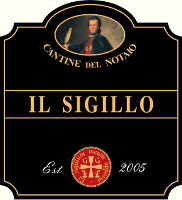
|
|
Aglianico del Vulture Il Sigillo 2005 |
|
| Cantine del Notaio (Basilicata, Italy) | |
| Grapes: Aglianico | |
| Price: € 36.00 | Score: |
| Aglianico del Vulture Il Sigillo shows an intense ruby red color and nuances of ruby red, little transparency. The nose denotes intense, clean, pleasing, refined and elegant aromas which start with hints of plum, blackberry and black cherry followed by aromas of blueberry, violet, vanilla, tobacco, pink pepper, chocolate, mace and menthol. The mouth has good correspondence to the nose, full body, intense flavors, pleasing roundness. The finish is persistent with flavors of blackberry, plum and black cherry. Aglianico del Vulture Il Sigillo ages for 24 months in barrique. | |
| Food Match: Selvaggina, Carne arrosto, Brasati e stufati di carne, Formaggi stagionati | |

|
|
Aglianico del Vulture La Firma 2006 |
|
| Cantine del Notaio (Basilicata, Italy) | |
| Grapes: Aglianico | |
| Price: € 32.00 | Score: |
| Aglianico del Vulture La Firma shows an intense ruby red color and nuances of ruby red, little transparency. The nose reveals intense, clean, pleasing, refined and elegant aromas that start with hints of blackberry, black cherry and plum followed by aromas of violet, vanilla, blueberry, pink pepper, chocolate, mace, leather, tobacco and menthol. The mouth has good correspondence to the nose, a tannic attack and however balanced by alcohol, full body, intense flavors, pleasing roundness. The finish is very persistent with long flavors of blackberry, black cherry and plum. Aglianico del Vulture La Firma ages for 12 months in cask followed by 12 months of aging in bottle. | |
| Food Match: Game, Roasted meat, Stewed and braised meat, Hard cheese | |
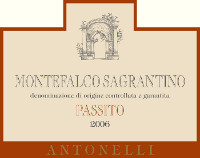
|
|
Sagrantino di Montefalco Passito 2006 |
|
| Antonelli San Marco (Umbria, Italy) | |
| Grapes: Sagrantino | |
| Price: € 25.00 - 375ml | Score: |
| This Sagrantino di Montefalco Passito shows a dark ruby red color and nuances of ruby red, little transparency. The nose reveals intense, clean, pleasing, refined and elegant aromas that start with hints of blackberry, black cherry and violet followed by aromas of plum, blueberry, vanilla, tobacco, chocolate, pink pepper, cinnamon, licorice and menthol. The mouth has good correspondence to the nose, a sweet and tannic attack, however balanced by alcohol, full body, intense flavors, pleasing roundness. The finish is persistent with flavors of blackberry, plum and black cherry. This Sagrantino di Montefalco Passito ages for 12 months in cask followed by 16 months of aging in bottle. | |
| Food Match: Fruit desserts, Confectionery, Hard cheese | |

|
|
Sagrantino di Montefalco Chiusa di Pannone 2004 |
|
| Antonelli San Marco (Umbria, Italy) | |
| Grapes: Sagrantino | |
| Price: € 36.00 | Score: |
| Sagrantino di Montefalco Chiusa di Pannone shows an intense ruby red color and nuances of ruby red, little transparency. The nose reveals intense, clean, pleasing, refined and elegant aromas that start with hints of blackberry, plum and black cherry followed by aromas of blueberry, violet, vanilla, tobacco, chocolate, leather, mace, pink pepper and menthol. The mouth has good correspondence to the nose, a tannic attack and however balanced by alcohol, full body, intense flavors, agreeable. The finish is very persistent with long flavors of blackberry, plum and black cherry. Sagrantino di Montefalco Chiusa di Pannone ages for 18 months in cask, 3 months in cement tanks and for 2 years in bottle. | |
| Food Match: Game, Roasted meat, Stewed and braised meat, Hard cheese | |
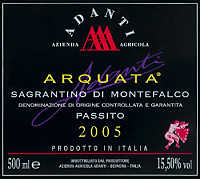
|
|
Sagrantino di Montefalco Passito 2005 |
|
| Adanti (Umbria, Italy) | |
| Grapes: Sagrantino | |
| Price: € 33.00 - 500ml | Score: |
| This Sagrantino di Montefalco Passito shows a deep ruby red color and nuances of garnet red, little transparency. The nose reveals intense, clean, pleasing, refined and elegant aromas that start with hints of blackberry, black cherry and dried violet followed by aromas of plum, blueberry, vanilla, tobacco, chocolate, cinnamon, licorice, lavender, mace, pink pepper and menthol. The mouth has good correspondence to the nose, a sweet and tannic attack, however balanced by alcohol, full body, intense flavors, pleasing roundness. The finish is persistent with flavors of blackberry, black cherry and plum. This Sagrantino di Montefalco Passito ages for 24 months in cask. | |
| Food Match: Hard cheese, Wild berries tarts | |
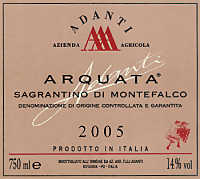
|
|
Sagrantino di Montefalco |
|
| Adanti (Umbria, Italy) | |
| Grapes: Sagrantino | |
| Price: € 23.00 | Score: |
| This Sagrantino di Montefalco shows an intense ruby red color and nuances of ruby red, little transparency. The nose reveals intense, clean, pleasing, refined and elegant aromas which start with hints of blackberry, black cherry and violet followed by aromas of plum, blueberry, vanilla, juniper, chocolate, cinnamon, tobacco, pink pepper, leather and menthol. The mouth has excellent correspondence to the nose, a tannic attack and however balanced by alcohol, full body, intense flavors, agreeable. The finish is very persistent with long flavors of blackberry, black cherry and plum. This Sagrantino di Montefalco ages for 28 months in cask followed by 12 months of aging in bottle. | |
| Food Match: Game, Roasted meat, Stewed and braised meat, Hard cheese | |
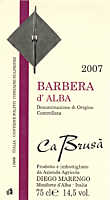
|
|
Barbera d'Alba 2007 |
|
| Ca' Brusà (Piedmont, Italy) | |
| Grapes: Barbera | |
| Price: € 6.50 | Score: |
| This Barbera d'Alba shows an intense ruby red color and nuances of ruby red, little transparency. The nose denotes intense, clean, pleasing and refined aromas that start with hints of cherry, plum and violet followed by aromas of blueberry, chocolate, vanilla and menthol. The mouth has good correspondence to the nose, a tannic attack and however balanced by alcohol, good body, intense flavors, pleasing crispness. The finish is persistent with flavors of cherry, plum and blueberry. This Barbera d'Alba ages for 6 months in barrique followed by 6 months of aging in bottle. | |
| Food Match: Broiled meat and barbecue, Stewed meat with mushrooms, Hard cheese | |
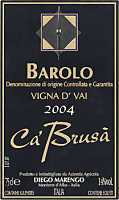
|
|
Barolo Vigna d'Vai 2004 |
|
| Ca' Brusà (Piedmont, Italy) | |
| Grapes: Nebbiolo | |
| Price: € 20.00 | Score: |
| Barolo Vigna d'Vai shows a brilliant ruby red color and nuances of garnet red, moderate transparency. The nose reveals intense, clean, pleasing and refined aromas which start with hints of cherry, plum and violet followed by aromas of vanilla, chocolate, mace, cinnamon, leather and menthol. The mouth has good correspondence to the nose, a tannic attack and however balanced by alcohol, full body, intense flavors, pleasing crispness. The finish is persistent with flavors of cherry and plum. Barolo Vigna d'Vai ages for 15 months in barrique, 10 months in cask and 12 months in bottle. | |
| Food Match: Game, Roasted meat, Stewed and braised meat, Hard cheese | |
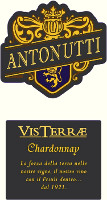
|
|
Friuli Grave Chardonnay Vis Terrae 2007 |
|
| Antonutti (Friuli Venezia Giulia, Italy) | |
| Grapes: Chardonnay | |
| Price: € 12.00 | Score: |
| Friuli Grave Chardonnay Vis Terrae shows a brilliant golden yellow color and nuances of straw yellow, very transparent. The nose reveals intense, clean, pleasing and refined aromas which start with hints of pear, banana and plum followed by aromas of apple, grapefruit, passion fruit, praline and vanilla. The mouth has good correspondence to the nose, a crisp attack and however balanced by alcohol, good body, intense flavors, agreeable. The finish is persistent with flavors of banana, apple and plum. A part of Friuli Grave Chardonnay Vis Terrae ferments and ages in barrique. | |
| Food Match: Stuffed pasta, Stewed fish, Roasted fish | |
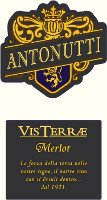
|
|
Friuli Grave Merlot Vis Terrae 2004 |
|
| Antonutti (Friuli Venezia Giulia, Italy) | |
| Grapes: Merlot | |
| Price: € 12.00 | Score: |
| Friuli Grave Merlot Vis Terrae shows an intense ruby red color and nuances of garnet red, little transparency. The nose denotes intense, clean, pleasing and refined aromas which start with hints of black currant, plum and black cherry followed by aromas of blueberry, dried violet, vanilla, tobacco, chocolate and menthol. The mouth has good correspondence to the nose, a tannic attack and however balanced by alcohol, good body, intense flavors, pleasing roundness. The finish is persistent with flavors of black currant, black cherry and plum. Friuli Grave Merlot Vis Terrae ages in barrique for 18 months. | |
| Food Match: Roasted meat, Stewed and braised meat, Hard cheese | |

|
|
Pinot Grigio Valparadiso 2009 |
|
| Fattori (Veneto, Italy) | |
| Grapes: Pinot Gris | |
| Price: € 15.00 | Score: |
| Pinot Grigio Valparadiso shows a brilliant greenish yellow color and nuances of greenish yellow, very transparent. The nose denotes intense, clean, pleasing and refined aromas that start with hints of pear, banana and peach followed by aromas of citrus fruits, apple, broom and mineral. The mouth has good correspondence to the nose, a crisp attack and however balanced by alcohol, good body, intense flavors, agreeable. The finish is persistent with flavors of pear, banana and peach. Pinot Grigio Valparadiso ferments in steel tanks and cask. | |
| Food Match: Pasta and risotto with fish and crustaceans, Sauteed fish, Fried fish | |
News |
|
In this section are published news and information about events concerning the world of wine and food. Whoever is interested in publishing this kind of information can send us a mail to our address.
|
AquavitaeReview of Grappa, Distillates and Brandy |
|
|
| Distillates are rated according to DiWineTaste's evaluation method. Please see score legend in the "Wines of the Month" section. |
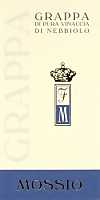
|
|
Grappa di Nebbiolo |
|
| Mossio (Piedmont, Italy) | |
| (Distiller: Distilleria Montanaro) | |
| Raw matter: VPomace of Nebbiolo | |
| Price: € 27.00 - 70cl | Score: |
| This grappa shows a pale golden yellow color, transparent and crystalline. The nose reveals intense, clean, pleasing and refined aromas of prune, black cherry, hazelnut, vanilla, tobacco, honey, licorice and chocolate, with almost imperceptible alcohol pungency. In the mouth has intense flavors with perceptible alcohol pungency which tends to dissolve rapidly, good correspondence to the nose, pleasing roundness, balanced sweetness. The finish is persistent with flavors of prune, honey and licorice. This grappa is produced with a steam operated discontinuous alembic still and ages for more than one year in cask. | |
Wine Parade |
|
|
| The best 15 wines according to DiWineTaste's readers. To express your best three wines send us an E-mail or fill in the form available at our WEB site. |
| Rank | Wine, Producer | |
|---|---|---|
| 1 |
| Aglianico del Vulture La Firma 2004, Cantine del Notaio (Italy) |
| 2 |
| Barolo Sorano 2004, Alario (Italy) |
| 3 |
| Barolo Bussia 2001, Prunotto (Italy) |
| 4 |
| Sagrantino di Montefalco Passito 2004, Adanti (Italy) |
| 5 |
| Collio Bianco Col Dis˘re 2004, Russiz Superiore (Italy) |
| 6 |
| Arkezia Muffo di San Sisto 2004, Fazi Battaglia (Italy) |
| 7 |
| Blanc des Rosis 2006, Schiopetto (Italy) |
| 8 |
| Sagrantino di Montefalco Collepiano 2003, Arnaldo Caprai (Italy) |
| 9 |
| Merlot 2004, Castello delle Regine (Italy) |
| 10 |
| Sagrantino di Montefalco 25 Anni 2005, Arnaldo Caprai (Italy) |
| 11 |
| Brunello di Montalcino Progetto Prime Donne 2004, Donatella Cinelli Colombini (Italy) |
| 12 |
| Villa Gresti 2004, Tenuta San Leonardo (Italy) |
| 13 |
| Aglianico del Vulture Il Repertorio 2006, Cantine del Notaio (Italy) |
| 14 |
| Sangiovese di Romagna Superiore Riserva Thea 2005, Tre Monti (Italy) |
| 15 |
| San Leonardo 2001, Tenuta San Leonardo (Italy) |
| |||||||
Privacy Policy | |||||||


| Copyright © 2002-2024 Antonello Biancalana, DiWineTaste - All rights reserved |
| All rights reserved under international copyright conventions. No part of this publication and of this WEB site may be
reproduced or utilized in any form or by any means, electronic or mechanical, without permission in writing from DiWineTaste. |